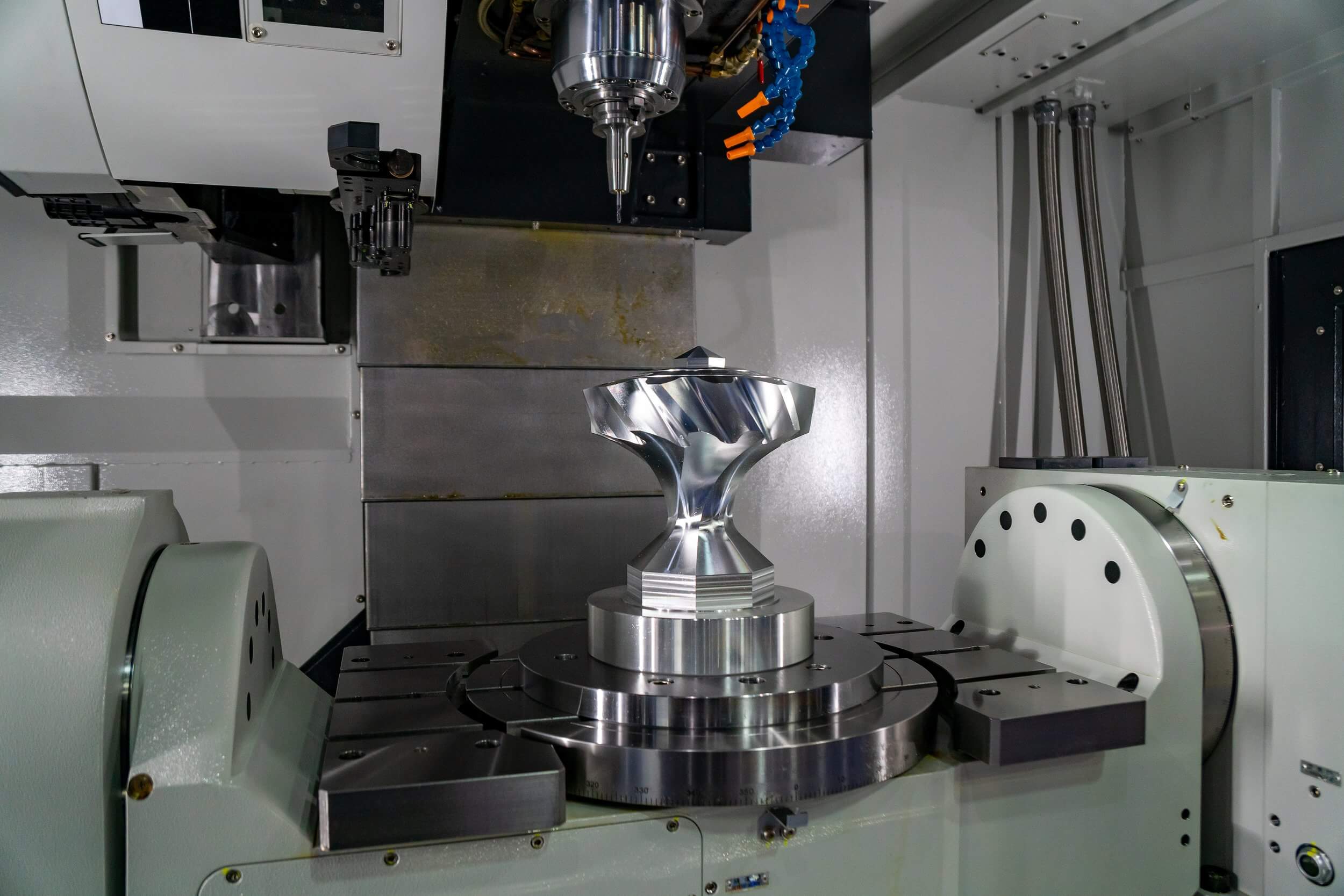How 5 axis CNC Machining Work and Their Applications
5 axis CNC machining use machines that can move and rotate in five axes simultaneously to machine parts. Benefits include being well-suited for manufacturing parts with complex designs and intricate details, and high precision, speed, and productivity.
Imagine the most complex CNC machined part you’ve ever seen; there’s a good chance its manufacturer relied on 5 axis CNC machining. However, you can only use the process or outsource it to a CNC machining center once you understand it.
This article will guide you through the CNC machining process, designed to be successfully integrated into your projects. It will define the process, explain how it works, and describe its typical applications.
Table of Contents
1.What is 5 axis CNC machining?
5 axis CNC machining services are a type of CNC machining that relies on the use of a 5 axis CNC machine that can move and rotate five axes simultaneously (three linear and two rotary).
Generally speaking, the three linear axes are the basic axes that aid in cutting. The three rotary axes are auxiliary axes, and the machine can only use two. They only help to correctly position the workpiece (not involved in cutting).
The number of axes you can link to at the same time is also limited, as this leads to higher control system complexity, programming complexity, and mechanical limitations.
A 5 axis CNC machining setup is more versatile than traditional 3-axis and 4-axis CNC setups because it can move and rotate more axes. In addition, its configuration eliminates the need for multiple setups. Therefore, there is less supervision and production efficiency is higher.
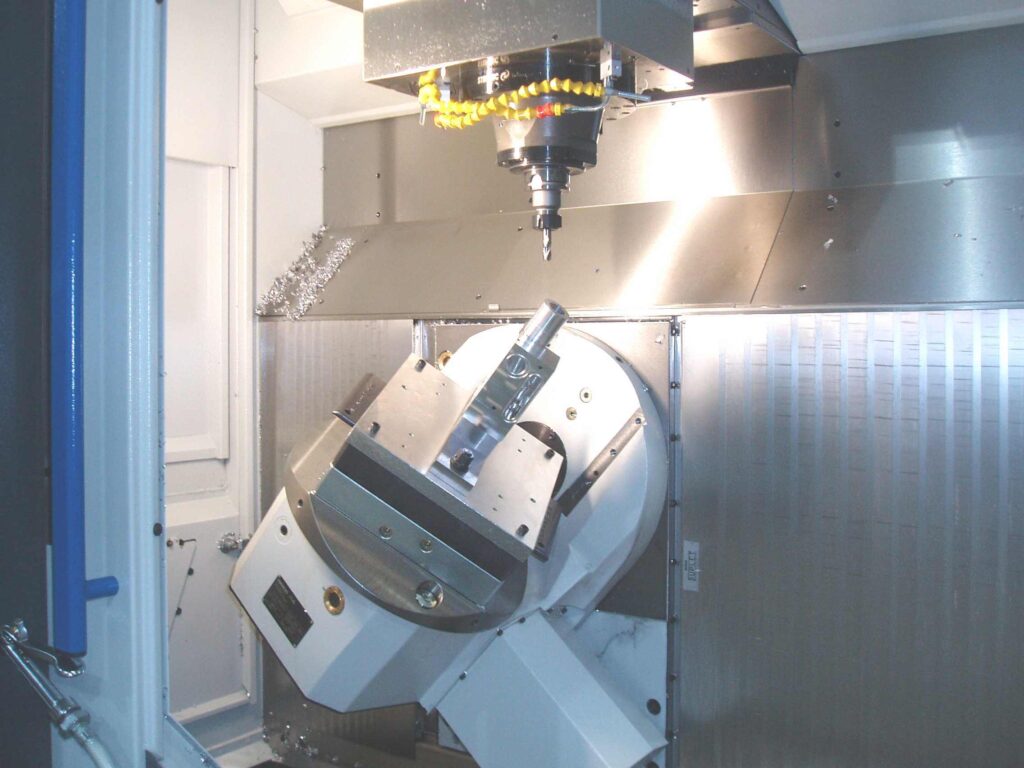
2.What are the 5 axes in 5 axis CNC machining?
“5 axis” in CNC machining technology stands for the five axes that the cutting tool can move and rotate simultaneously. A typical CNC machine has three linear axes (basic axes) and three rotary axes (A, B, and C), and a 5 axis machine will move along the linear axes and two rotary axes.
1) X-axis
The X-axis represents the horizontal movement of the cutting tool along the length of the machine, which can be from left to right or right to left depending on the machine configuration. Movement along the X-axis enables CNC machining operations such as milling, drilling, and contouring.
2) Y-axis
The Y-axis represents the lateral movement of the cutting tool, which can be front to back or back to front, depending on the machine configuration. Movement along the Y-axis enables CNC machining operations such as side milling, slotting, and profiling.
3) Z-axis
The Z-axis represents the vertical movement of the cutting tool. Depending on the type of 5 axis CNC machine, the movement can be up and down. Movement along the Z-axis enables CNC machining operations such as drilling, tapping, and boring.
4) A-axis
The A-axis represents the rotational movement of the cutting tool around the X-axis – tilting or rotating. This axis provides greater flexibility and is compatible with undercuts, chamfers, and angled features.
5) B-axis
The B-axis represents the rotational movement of the cutting tool around the Y-axis. This axis enables multi-faceted machining and machining features such as deep grooves, complex contours, and curved surfaces.
6) C-axis
The C-axis represents the rotational movement of the cutting tool around the Z-axis – it tilts or rotates vertically.
Comparison of 3-axis, 4-axis, 3+2-axis and 5 axis CNC machining services
The significant difference between the different categories of CNC machines is the number of axes the cutting tool can move or rotate. The following table highlights the differences and similarities between 3-axis, 4-axis, 3+2-axis and 5 axis CNC machines.
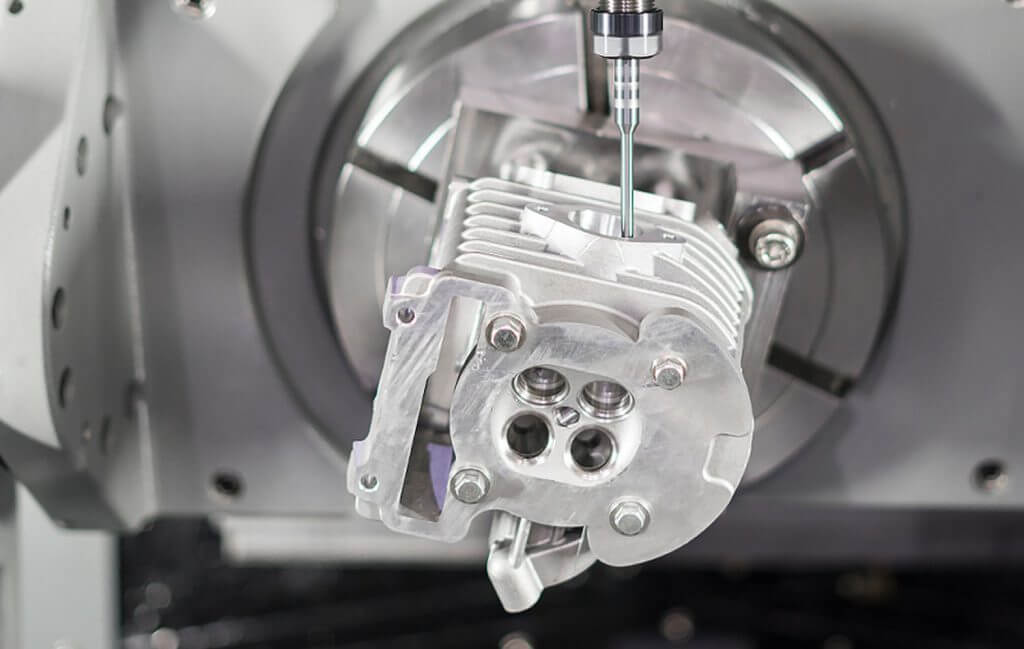
3.Types of 5 axis CNC machines
The main difference between the different types of 5 axis CNC machines is the location of the rotational axis (machine head or table). Below are three common 5 axis CNC systems, and you can choose the right one for your project.
1) Head/Head
Spindle head/Spindle head 5 axis machines have two rotational axes in the machine head. Therefore, since the table is fixed, there is no tool interference, ensuring that the workpiece is stationary.
The position of the rotary axes also ensures that 5 axis machines under this category can move around the workpiece. Therefore, they are suitable for machining large parts. In contrast, movement is still limited due to the focus of the two rotary axes in the head and fixed table.
2) Table/Head
CNC machines with table/head configuration have two rotary axes in both the head and the table. The rotary axes in the head have range limitations due to their position, while the rotary axes in the table have no limitations.
The advantage of table/head machining over head/head machining is that since the part is always rotating, it is not limited. In contrast, since the workpiece is located on the rotary axes, the number of parts that can be machined is limited.
3) Table/Table
Table/Table 5 axis machines have two rotary axes on the table. This limits the rotary axes, making the machine suitable only for machining undercuts. In addition, the table/table has the smallest working range and is slower than other 5 axis CNC machines (without motors). It is not suitable for machining large or heavy parts.
4.Benefits of 5 axis CNC Machining
5 axis CNC systems continue to be a good machining choice for many part manufacturers because of the following great benefits that stand out:
1) Suitable for Complex Designs
The most common reason part manufacturers choose 5 axis CNC machines is that they are suitable for machining complex machine shapes. Prior to their development, such parts were made using a casting process that is known for long lead times.
In contrast, 5 axis machines are fast, and their additional motion allows parts to be machined at different angles and arcs without special fixtures or additional setups.
2) Reduced Re-Clamping
5 axis CNC machining services eliminate the need to manufacture parts in sections, which requires fixtures. The machine can approach the workpiece at different angles with fewer setups.
3) Reduced Labor Cost Per Part
5 axis CNC machining services save time and money because the machine operator does not need to touch the workpiece; no re-clamping is required.
4) Better Surface Finish
Other CNC machines, especially 3-axis machines, require longer lead times to achieve a better surface finish. However, 5-axis machines can achieve a better surface finish in a shorter time. You can use short cutting tools to reduce vibration, thereby ensuring a better surface finish
5) Feature-to-Feature Accuracy
5-axis machines have a zeroing or homing function that reduces alignment errors due to setup changes or removal of parts from the machine. It also reduces the possibility of incorrect alignment during machining.
6) Faster Cutting Speeds
5-axis CNC machines have shorter tools that ensure faster cutting speeds, reduced tool loads, and less vibration and breakage, thereby extending tool life. In addition, due to the addition of a rotary axis, better head positioning is achieved, so drilling speeds are faster than traditional CNC machines.
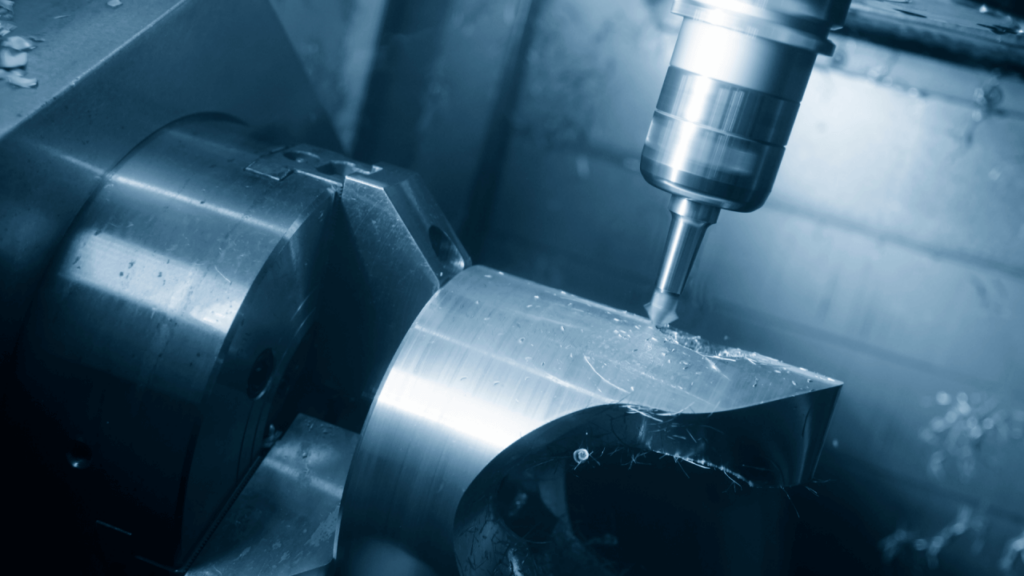
5.Disadvantages of 5 axis CNC machining
Of course, these types of CNC machines also have their limitations, including the following:
1) Cost
Incorporating a 5 axis CNC machine into your machine tool setup will incur higher costs than a traditional CNC machining center. In addition, due to its higher complexity, maintenance costs are also higher. You can reduce costs by outsourcing to a CNC machining supplier that offers 5 axis machining services.
2) CAD/CAM Programming
It is more difficult to program the movement of each axis because two additional rotary axes are included in addition to the three linear movements. This means that you must consider the movement of each axis to prevent interference and collision. Due to the complexity and the requirements for machining accuracy and surface quality, you may need the services of a qualified CAD/CAM programmer.
3) Requires advanced operating skills
In addition to complex CAD/CAM programming, 5 axis machining also requires highly skilled operators due to its advanced technology.
6.How to Configure a 5 axis CNC Machine
Configuring a 5 axis CNC machine is easy because it does not require a complex clamping system or fixtures to hold the workpiece.
1) Prepare the holding equipment
Use zero clamps, hydraulic clamps or firmly mounted blocks to securely mount the workpiece in the center of the machine table. The workpiece must be securely fixed and accessible from five sides before machining.
2) Prepare the cutting tools
Prepare, measure and load the cutting tools and tool holders into the machine’s automatic tool changer (ATC) magazine.
3) Perform calibration
Before starting production, calibrate the machine using specific software and automatic measurement probes. This ensures accurate calibration of all axes and minimizes tolerance accumulation.
4) Check for potential collisions
Before starting a machining cycle, carefully check for any potential collision areas. Verify the correctness of each position and the accuracy of each tool change.
5) Check before running the program
Run the entire program step by step to verify the correctness of each position and tool change. This helps prevent crashes and ensure smooth operation.

7.Applications of 5 axis CNC machining
5 axis CNC machining services reduce human errors, improve consistency and ensure high-quality machining. The following industries use CNC machining technology in part manufacturing.
1) Aerospace Industry
The aerospace industry is increasingly relying on 5 axis machining because of its high precision and the fact that many aerospace parts are designed intricately and require machine-to-machine machining of hard-to-reach areas. A classic example of a 5 axis machined part is a turbine blade, which is first cast and then machined to achieve the desired shape and surface finish.
2) Automotive Industry
The automotive industry relies on 5 axis machines because manufacturing tools require consistency and tight tolerances. The industry primarily favors low-cost manufacturing options such as die casting and injection molding, while 5 axis CNC machines are used for mold making and other machining processes.
3) Medical Industry
The medical industry requires a manufacturing process that can achieve high quality and is compatible with different materials. While 3-axis and 4-axis machining are suitable for this industry, 5 axis machining is better when dealing with complex parts. In addition, CNC machines are suitable for medical impellers and CT scanner components.
4) Energy Industry
The energy industry is the backbone of all other industries; it requires advanced components that push the limits of engineering and material usage. Therefore, it constantly relies on 5 axis CNC machining services. Examples of 5 axis CNC machining service parts in the energy industry are drills, pistons, cylinders, rods, cylinders, and valves.
5) Industrial Sector
The industrial sector is wide-ranging and requires complex components, and 5 axis machines are suitable. However, they play more of a supporting role, as general-purpose CNC machines such as 3-axis and 4-axis machines are a common choice given the cost and general types of parts produced.
8.5 axis CNC Machining Service Tips
To maximize productivity and efficiency in your 5 axis machining process, you can explore the practices and tips highlighted below:
1) Optimizing Tool Paths
Optimizing tool paths involves selecting the most efficient and effective paths to ensure minimal waste and maximum precision during machining. Software tools can be used to optimize tool paths. Adaptive milling can also be used, which allows the CNC machine to adjust the cutting speed and depth based on the workpiece.
2) Using the Right Tools and Materials
Using the right tools and materials ensures high quality of machined parts, reduces waste, and reduces machining time.
When selecting a tool, consider the following:
- Material being cut
- Depth of cut
- Desired results
High-speed steel (HSS) tools are best for soft materials, carbide tools for harder materials, and diamond-coated tools for abrasive materials such as composites and ceramics.
When selecting a material, consider its properties and how they match up with the end-application component. For example, choose titanium or stainless steel for a high-strength component and aluminum or magnesium for a lightweight component.
3) Maintain your machine and tools
Regular maintenance of your 5 axis CNC mill and other tools ensures that you are operating at peak performance, reducing downtime and improving part quality. Maintenance practices include:
- Keeping the machine clean regularly
- Lubricating machine components as recommended by the manufacturer
- Sharpening and changing tools as recommended by the manufacturer
4) Optimizing cutting parameters
Optimize cutting parameters such as cutting speed, feed rate, and depth of cut to reduce machining time and improve part quality. You can start with lower values and gradually increase them to achieve the desired results. In addition, they should be monitored during machining and adjusted as needed.
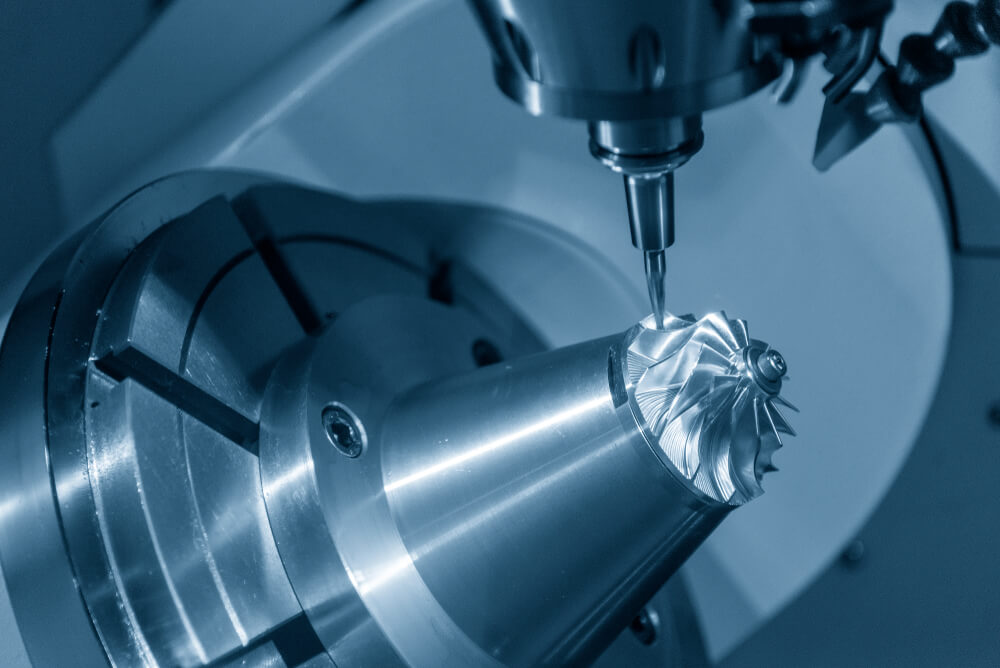
9.Xavier 5 axis CNC machining services
Ensuring quality in 5 axis CNC machining services requires skills. Therefore, the best way to achieve quality at an affordable cost is to outsource to a reputable 5 axis CNC machining service provider.
At Xavier, we provide quality 5 axis CNC machining services to different industries. Our team of engineers are experts in CNC machining material selection and will advise you on high-quality machining.
Conclusion 5 axis CNC machining services allow you to manufacture parts with complex designs while enjoying benefits such as simpler machining operations, speed, and productivity. If you are looking for CNC machining services, contact us.
